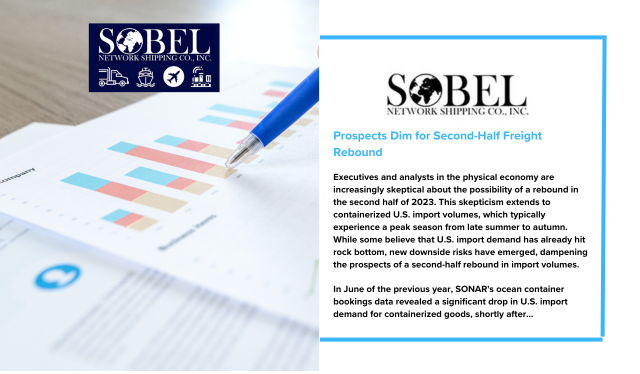Executives and analysts in the physical economy are increasingly skeptical about the possibility of a rebound in the second half of 2023. This skepticism extends to containerized U.S. import volumes, which typically experience a peak season from late summer to autumn. While some believe that U.S. import demand has already hit rock bottom, new downside risks have emerged, dampening the prospects of a second-half rebound in import volumes.
In June of the previous year, SONAR’s ocean container bookings data revealed a significant drop in U.S. import demand for containerized goods, shortly after FreightWaves’ U.S. truckload data had signaled an impending freight recession. Now, the freight recession of 2023 has officially taken hold.
The latest data from SONAR on ocean container bookings indicates that U.S. containerized import volumes in 2023 have been tracking alongside 2019 levels, which coincided with the previous freight recession. While this trend was expected, caution is advised before assuming that import volumes have already bottomed out for this downturn and are poised for a second-half rebound during the peak season.
The import volumes in the second half of 2019 followed an irregular pattern, without a clear rebound during the traditional peak season months. The latest data on U.S.-bound container volumes departing from China once again highlights the persistent weakness in U.S. import demand, with no evident signs of a rebound. This weakness is further confirmed by the contraction in Chinese manufacturing data in April, as reported by the National Bureau of Statistics. The decline in the manufacturing Purchasing Managers’ Index (PMI) below the midpoint of 50, indicating contraction, suggests that hopes for a surge in container volumes resulting from a reopening of China are fading. Without a rebound in the manufacturing sector of the United States’ largest trading partner for containerized ocean imports, the likelihood of a second-half rebound in U.S. import volumes appears even more improbable.
Initially, the excessive inventories carried over from 2022 posed a significant hurdle to import demand in the first half of 2023. It was expected that importers would deplete these inventories in the first six months of the year, paving the way for a typical seasonal replenishment cycle that would boost volumes in the second half, just in time for the peak season. However, the latest inventory data from the Logistics Managers’ Index (LMI) indicates that inventory levels and costs are still expanding, suggesting that importers continue to struggle with reducing excess inventories.
The challenge faced by U.S. importers in depleting excessive inventories is further exacerbated by weakening consumer demand. Recent credit card data from the Bank of America (BOA) indicates a sharp decline in card spending per household in March, adding to concerns about declining retail sales. Additionally, other indicators, such as rising delinquency rates and increasing consumer debt through the use of “buy now, pay later” options, point to the risks surrounding U.S. consumer demand in the second quarter. These concerns further emphasize the role of the U.S. labor market in the financial health of consumers. However, the labor market itself is showing worrisome signals, with an increase in initial jobless claims and a decline in job openings and private sector job growth.
All of these economic concerns are likely to be magnified in May if the Federal Reserve decides to raise interest rates. The U.S. financial sector is already facing a credit crunch due to recent bank failures, which could exacerbate the challenges faced by the economy. The markets are indicating a possible end to the rate-hiking cycle and even potential rate cuts in the second half of the year, reflecting the belief that economic conditions will worsen. In previous economic downturns,


